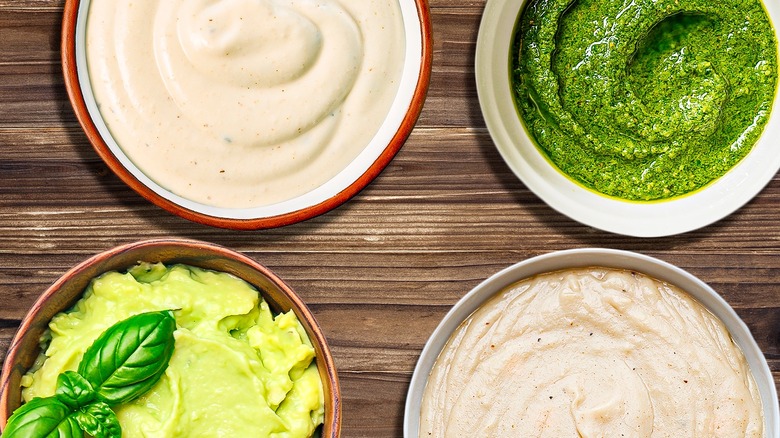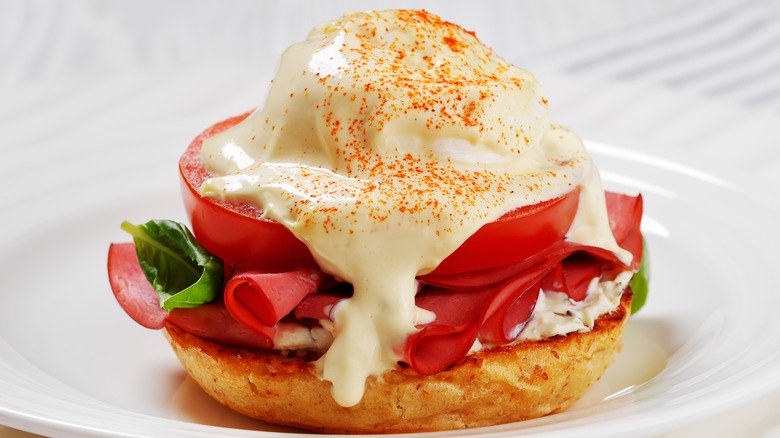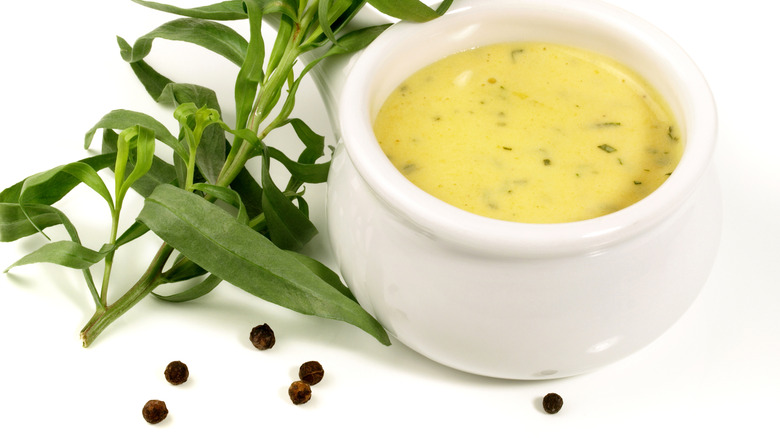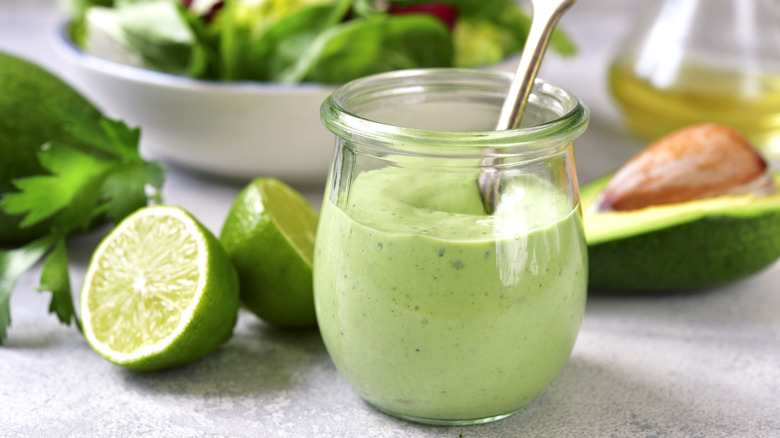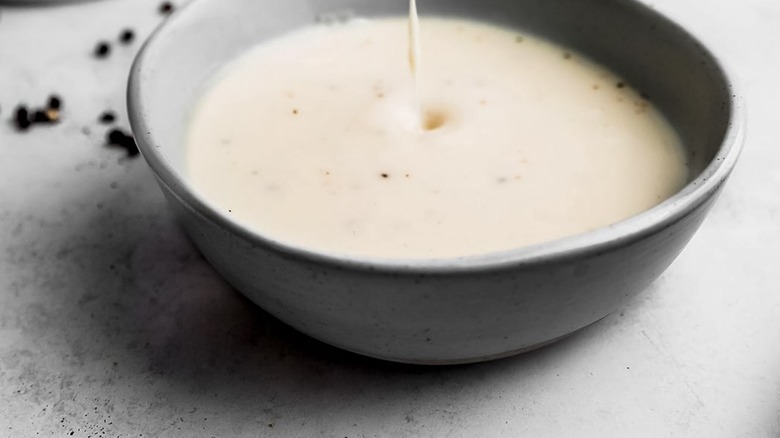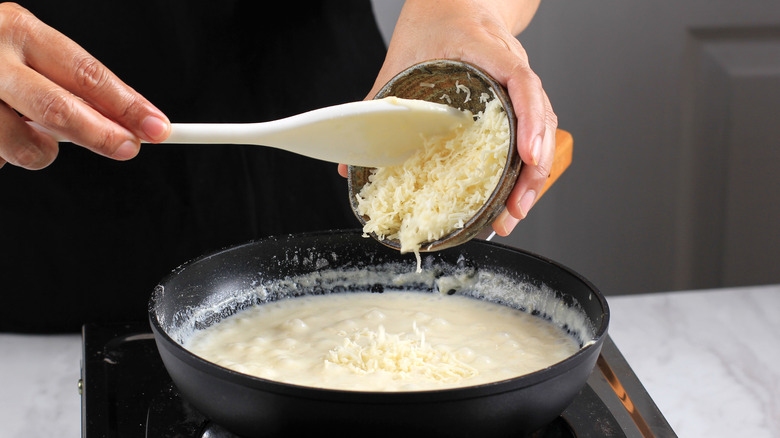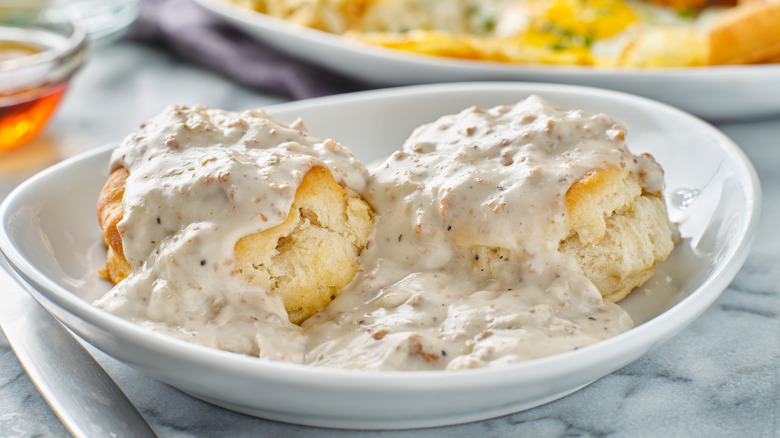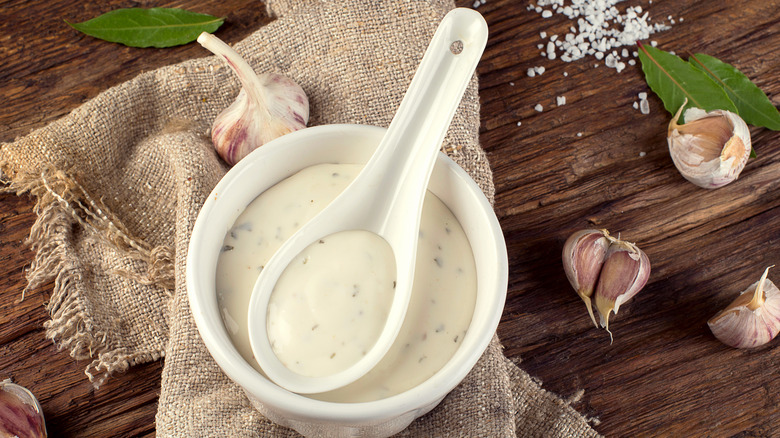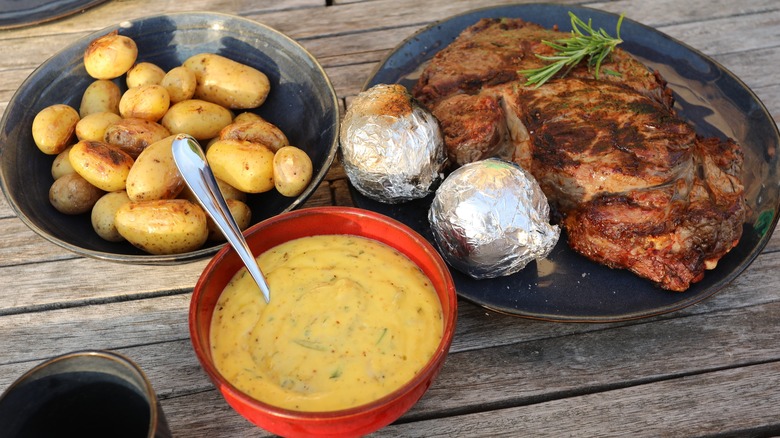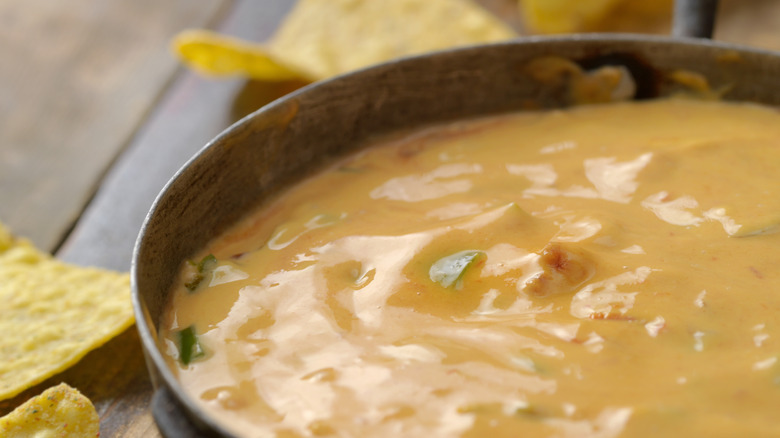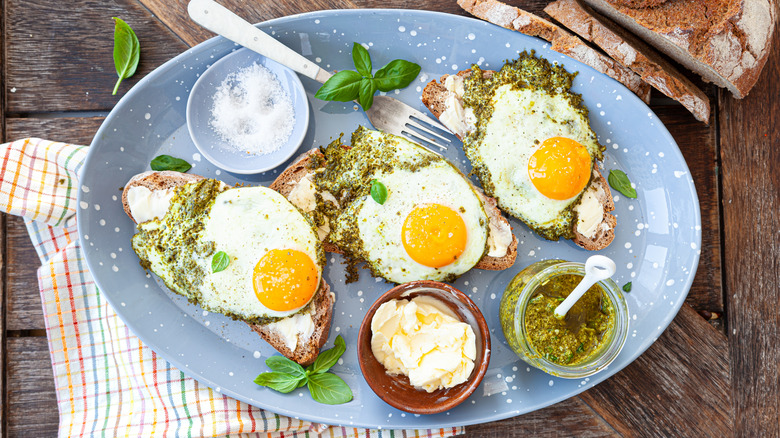10 Best Substitutes For Hollandaise Sauce
There are few pleasures in life as decadent as a well-made hollandaise sauce. It's hard to beat the rich, velvety goodness that takes over your taste buds as you bite into an eggs Benedict coated in the silky emulsion. But tangy, buttery hollandaise can also be paired with seafood, vegetables or meat. While the French sauce is synonymous with brunch at a restaurant, it can be terrifying to attempt at home for its time-consuming and technical nature. It's often hard for cooks to achieve the perfect texture for this emulsion of egg yolks, butter and lemon juice.
The challenge that a homemade hollandaise presents isn't the only reason to look for other options though. Maybe you're looking for a healthier substitute to the sauce that tends to be quite high in saturated fats, and so best consumed in moderation. Or you're looking for a plant-based alternative. Maybe you just want to switch it up and add a unique kick to your eggs Benedict. Here are some of our favorite replacements for hollandaise sauce.
Mock hollandaise sauce
As the name suggests, a mock hollandaise is an attempt to mimic the hollandaise sauce, albeit in a simpler, less intimidating way. There are many recipes that come together with easy-to-find ingredients like butter, mustard, or mayonnaise and closely resemble the real thing. One way to make it is to whisk together equal parts melted butter and mayonnaise with a dash of lemon juice. Or try this slightly more adventurous take with some interesting additions, like orange juice.
The beauty of a mock hollandaise is that it can be easily tweaked to accommodate various dietary preferences. While most recipes are already gluten-free, those who don't consume dairy can use vegan mayonnaise and plant-based margarine instead. Drizzle it over poached eggs on buttered English muffins and wilted spinach for a satisfying meal of eggs Florentine, or brighten up some roasted asparagus. The options are endless. The best part? The creamy sauce takes mere minutes to make and drips lusciously down the sides, just like the non-mock version.
Béarnaise sauce
Another beloved French classic, the béarnaise sauce is interestingly referred to as the child of the hollandaise, one of the five French mother sauces, along with béchamel, espangole, tomato, and velouté. Still, it's less complicated than the original and doesn't require as much skill or time to whip up. It's made of similar ingredients as hollandaise: egg yolks and butter, with some fun additions including shallots and fresh herbs like tarragon and chervil. And while hollandaise derives its acidity from lemon juice, béarnaise uses white wine vinegar. It's also made in a similar fashion — by emulsifying egg yolk and room temperature butter with herb-infused vinegar and a shallot reduction, sprinkled with black paper.
This delightful, creamy béarnaise sauce goes well with a variety of dishes, from a luxurious ribeye steak to sides such as roasted vegetables. Just like the hollandaise, it's also the perfect topping for eggs Benedict, but with a distinct flavor profile. The béarnaise's fresh ingredients give it a herby, savory kick that sets it apart from the hollandaise's acidity and elevates any simple dish it's paired with.
Avocado sauce
No mention of brunch is complete without a nod to everyone's favorite — avocados. From toasts and smoothies to even pasta sauce, avocados are now in everything. It's no surprise then that they also make a healthy, nutritious substitute for hollandaise sauce. Rich in unsaturated fats, avocados can help maintain healthy cholesterol levels when replacing foods high in saturated fats. Blend avocados with lemon juice and olive oil and season with salt and black paper, and you get a light, creamy, and equally delicious take on a traditional hollandaise. What's more, this sauce is completely plant-based and perfect for a vegan or dairy-free diet.
If you prefer a richer version of avocado salsa, add yogurt and either mayonnaise or cream for a luscious avocado spread. A creative departure from a typical hollandaise, this sauce is ridiculously quick to make, doesn't require any whisking, and the chances of it splitting are few, so you can relax and enjoy it over a cozy Sunday brunch of eggs Benny or as a fresh, light topping for hearty roasted fingerling potatoes.
Béchamel sauce
Just like hollandaise, béchamel is one of French cuisine's five mother sauces. But while hollandaise is made by emulsifying clarified butter into lemon juice and egg yolks, béchamel is an emulsion of flour into butter. Also known as "white sauce," it traditionally comes together by making a roux with simple ingredients like flour, butter, milk, and a little bit of patience. Heat some butter over low heat, and add in the flour, followed by the milk, stirring constantly to ensure there are no lumps.
The thickness of the sauce can be tailored to your liking and what you're using it for. Prefer a thinner sauce to drizzle over grilled veggies or meat? Just add in some more milk. Need it thick for pasta sauce or an egg topping? Cook it a little longer while whisking constantly. If you need a dairy-free version, just try subbing out the milk and butter for plant-based options.
Even with the risk of lumps, a béchamel is difficult to mess up, unlike fellow mother sauce, hollandaise. Although some might consider it bland, it can easily be spiced up by adding a hint of nutmeg, pepper, or even an onion pique, like in this special recipe that might change your béchamel forever. When made well, it clings to roasted veggies or meat just like a hollandaise does; its rich, silky texture makes sure you lick your plate clean.
Mornay sauce
If you prefer your sauces cheesy, this is the one for you. A simple, classic French sauce like some others already mentioned, mornay sauce is essentially a béchamel made even creamier with cheese. Traditionally, a mornay is enriched with Gruyère cheese, but sometimes, parmesan or cheddar also find their way into the cheesy mix. What makes mornay sauce special is its versatility. Not only does it make a great substitute for hollandaise on eggs Benedict, but it can also add a velvety touch to a classic Croque monsieur.
It's essential to get the roux right in the pursuit of a perfect mornay. It might seem natural that a darker roux means more flavor, yet it's best to keep the roux light when making mornay sauce. Not only is this sauce fuss-free but it can also be easily customized by using the type of cheese you want, based on your preferred consistency and flavor profile. What's more, it can also be covered and refrigerated for several days or frozen for up to three months, while a traditional hollandaise would last a couple of days at most, even in the fridge. Eggs Benedict on a lazy Sunday morning just got easier (and cheesier)!
Sausage gravy
Add a meaty, Southern twist to your eggs Benedict with a creamy, country sausage gravy. It's very different from a hollandaise in its composition and the way it's made. Made with finely chopped sausage and a roux, sausage gravy is closer to a béchamel. However, it's similar to hollandaise in that they're both rich, savory sauces that make for the perfect topping on a wide variety of food, ranging from bread to mashed potatoes. Although it might sound intimidating, there is such a thing as a simple sausage gravy — made in as little as 20 minutes with Italian sausage, oil, flour, garlic powder, salt, pepper, and milk.
To really lean into the Southern sense of comfort, you might want to give the English muffins a pass for some flaky buttermilk biscuits. If you want to add a hint of freshness to your meal, add a green salad on the side. And if you want to take the experimentation a step further and try a vegan alternative to the classic, go all out with vegan biscuits and tempeh sausage gravy.
Garlic aioli
An emulsion just like hollandaise, aioli is a punchier take blessed by the goodness of garlic. Seeing how aioli has made its mark as an elite ingredient in upscale restaurants, one might not expect that it only needs ingredients you already have at home. All a homemade garlic aioli requires is olive oil, eggs, garlic, lemon, salt, and pepper. It even comes together with just a blender or food processor — pulse all the ingredients except the oil in a blender until frothy. This is where things get a little technical. Pour in the oil slowly as you continue to pulse until the mixture is homogeneous.
Hollandaise is best drizzled over eggs; in comparison, the thicker consistency of aioli makes it an ideal dip for things you'd usually coat in hollandaise. It makes the perfect plunge for fries, wings, veggies, or grilled meat. What's more, spooning it on top of your eggs will give them a citrus, garlicky kick that'll elevate the flavor and go perfectly with a runny yolk. It can also act as a vehicle for inducing some experimental flavors into your eggs, be it with a slightly spicy paprika aioli or a more umami version with truffle.
Choron sauce
If hollandaise is a mother sauce and béarnaise its daughter, Choron sauce is probably a granddaughter sauce in French cuisine. Essentially a béarnaise with tomato paste added, this zesty, versatile sauce is a way to add acidity to a dish while still maintaining the original's creamy texture. The key to a good Choron (or béarnaise tomatée) is a béarnaise made with fresh, high-quality ingredients such as farm fresh egg yolks and grass-fed butter, accompanied by a third liquid; most commonly white wine vinegar, but tarragon vinegar and Champagne vinegar are also some options. Shallots, herbs like tarragon and chervil, and black pepper add a fresh, herby flavor to the sauce. Finally, the transformation is completed with some tomato paste for sweetness. In a pinch, tomato purée does the trick too.
Usually served warm, this sauce is best made not too far in advance, as the raw eggs might go off. It makes for a good substitute for hollandaise as it can be used in the same kinds of dishes as hollandaise or béarnaise, such as salmon. Naturally, this hollandaise sauce substitute pairs extremely well with perfectly poached eggs (eggs Choron, if you will), grilled meat, or even drizzled over veggies like potatoes and asparagus.
Sriracha cheese sauce
Cheesy flavors are always a welcome addition to a meal. When things veer into extra creamy territory, a little bit of spice goes a long way in offsetting some of that richness. A perfectly melted cheese sauce mixed with fiery sriracha is a great way to surprise your palette with a spicy kick. On its own, sriracha is the perfect addition on top of eggs, a bowl of ramen, or even avocado toast. By adding it to a cheese sauce, it gives you the perfect balance between mellowing umami and spice. The consistency of the sauce can easily be modified with water to make it a pourable hollandaise substitute or thickened for something closer to a dip.
When it comes to making the most gooey, melty cheese sauce, sodium citrate does the trick. As for homemade sriracha, it starts with blending and fermenting the key ingredients, including red jalapeños, garlic, two kinds of sugar, and salt. The mixture is then brought to a saucy consistency with vinegar, which helps bring some tartness into the sauce. If this process is too time-consuming for you, however, adding store-bought sriracha to your cheese sauce adds equal zing. Drizzle this sauce over your eggs, grilled fish, or vegetables, just like you would a hollandaise. In comparison, this is a flavor bomb that's cheesy, hot, and garlicky all at once.
Pesto
Adding a bright, fresh pesto to your food — one that's not heavy with cheese and oil — can be the perfect way of swapping out rich hollandaise, which might not be for everyone. The classic way to make this Italian sauce is with pine nuts, garlic cloves, basil leaves, olive oil, parmesan cheese, and salt. However, the name pesto comes not from the ingredients but from the technique used to make it. In order to suit your budget or dietary restrictions, it can be made with plant-based cheese, different nuts, and even avocado. The way to do it like an Italian nonna is to use a mortar and pestle, but blenders or food processors are the perfect modern adaptations to the original recipe. As a hollandaise substitute, it's a stark contrast just how easily pesto comes together.
Its versatile flavors go well with a wide variety of foods. Not only does it make for the most flavorful pasta sauce, but you can use it to top your eggs or fry them using pesto as the grease. When looking for a unique upgrade to a barbecue, you might even want to try a pesto and egg potato salad. This sauce is quite far removed from a hollandaise; what makes it a good hollandaise sauce substitute is how simply it comes together and the ease of storage. To save your pesto from turning brown, just store it in a container covered with a layer of olive oil.
